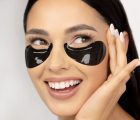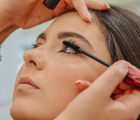Even a smooth and radiant face can become dull, sallow, and lackluster. Fortunately, you can restore its glow with intensive, illuminating skincare.

Cosmetics with particles that reflect light visually brighten the skin and even out skin tone. The effect disappears immediately when you wash the product off your face though. To nourish and moisturize your skin, you need to remove dead skin cells first. You don’t have to spend a fortune to improve the appearance of your complexion.
A glowing complexion: proper cleansing
Daily cleansing and proper makeup removal are the basis for beautiful and youthful skin. Improper removal of makeup, cosmetic residues, grease, dust, and toxins, the biggest enemies of our skin which clog pores, may end up in puffy and tired-looking skin.
If your skin is in really bad shape, start an intensive, brightening regenerative routine with a treatment at a professional beauty salon. At-home regeneration can be complemented by iontophoresis, which involves depositing highly nourishing substances into the skin.
Start your makeup removal routine with the eyes and lips, and then proceed with the rest of the face. The makeup remover must be tailored to the needs of your skin. You can use a product that dissolves dead skin cells but don’t use it to remove eye makeup. To wash off waterproof eyeshadow and mascara, press the cotton pad longer to allow makeup to dissolve. For oily or combination skin, a gel or foam cleanser will work well to tighten the pores and regulate sebum production. After thoroughly washing off your makeup, apply a face toner to balance your skin’s pH level and strengthen its protective barrier.
Brighter complexion: nourishing scrub
Regular exfoliation of dead skin cells ensures an even skin tone. It starts to look brighter and more radiant, all thanks to the stimulation of blood circulation. In the case of thicker skin, mechanical scrubs work best, while for dry skin care, it is best to use enzymatic scrubs which work just as well without irritating the skin.
How often to exfoliate the skin? Oily skin requires it twice a week, while for dry skin, once a week or every 10 days is enough.
Brightened skin: face masks
Right after exfoliating, apply a moisturizing and regenerative face mask. Do it preferably twice a week. After exfoliating the dead skin cells, the skin is ready for further treatments. There are many masks on the beauty market that work immediately. Properly lubricated and moisturized skin repays with a beautiful glow. Oily and combination skin needs white clay masks, while dry skin benefits from collagen, ceramide, or hyaluronic acid masks.
Glass skin: serums and face creams
Bet on brightening solutions with vitamin C which can protect the skin from free radicals. Other regenerative ingredients include vitamin A which regenerates the skin and lightens discolorations, vitamin D which evens out the skin tone, ginseng and horse chestnut which stimulate circulation. You should also try an intensive serum with vitamin C and minerals which visibly illuminates the face while tiny microparticles scatter light to make the complexion seem glowing. The illuminating pigments smooth the face and make wrinkles visually smoother.
Illuminated complexion: illuminating makeup
During the brightening treatment, you can also try to apply brightening makeup. Apply a special base to your face which can will further fix the makeup. Some cosmetics may gently tint the skin. Pigments that reflect light significantly rejuvenate and smooth the skin.
Then camouflage any imperfections with a green concealer and use a yellow one to cover dark circles and bruises below the eyes. The concealer, moreover, can help you fill in fine lines. Gently stretch the skin between your fingers and pat the product into the skin. Finally, highlight your complexion with an illuminating powder or face cream.
To keep your skin looking fresh, it needs to be naturally radiant, not shiny though. If your face tends to be seborrheic, use cosmetics that can inhibit oily skin while not clogging pores. It is also useful to use mattifying blotting papers to get rid of excess oil.




